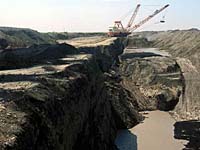
Fish are sensitive to a variety of pollutants, from herbicides and insecticides to mercury and heavy metals. Some of these pollutants accumulate in fish and can affect the health of people who eat the fish.

Heavy metals in mine tailings and effluents from pulp and paper mills and mining operation add zinc, cadmium, and lead to surface water. Leachate from mine tailings can add toxic pollutants to the water. Toxins accumulate in sediments and move through the food chain. Effects on the fish range from slow growth and poor reproduction to genetic defects and death. Tailing piles from mining operations have completely filled some lakes. The tailings, a source of acid in the water, are toxic to fish and aquatic organisms. |
Mercury is widespread in the environment and can be found in soils, water, air, plants and animals. It is easily transferred from one medium to another and it accumulates in food chains. Mercury, naturally present in soils, is released any time land is flooded. Bacteria convert the mercury to methyl mercury which is soluble in water and easily absorbed by fish. The amount of mercury available to fish increases with the area of land flooded. Most of the mercury fish ingest is from other aquatic organisms which have been consumed in their diet. Fish eliminate mercury very slowly and it accumulates in their muscle tissue and vital organs such as the liver and kidneys.
The longer fish are exposed to mercury in the environment, and the more mercury-contaminated food they consume, the higher levels of mercury in their tissues. Large fish contain more mercury than small fish of the same species. Predator fish have the highest levels because their diets consist of other fish which have already concentrated mercury in their tissues. For additional information regarding mercury, refer to "Mercury in Fish: Consumption Guidelines by Saskatchewan" Saskatchewan Parks and Renewable Resources, Fisheries Branch, 1992.
Ammonia from wastewater treatment plants and livestock waste is extremely toxic to fish. Only a few parts per million of un-ionized ammonia is enough to kill many fish.
Herbicides and insecticides used in ditches, utility corridors, gardens, forests and on farms, add long-lasting toxic chemicals to surface waters. Some chemicals have been found in toxic concentrations in sewage effluent from cities and towns. Chemicals enter the wastewater system after a rainfall. Storm sewers carry the chemicals directly into the river or through sewage treatment plants that do not remove them.
Widespread use of chemicals in crop production has led to surface water pollution. Pesticides can kill fish and the aquatic vegetation that provides food and cover. Chemical cling to soil particles that wind and water erosion carry into surface waters. Spraying for vegetation control too close to the water's edge increases suspended sediment in the water by killing vegetation that prevents erosion of banks and shorelines.